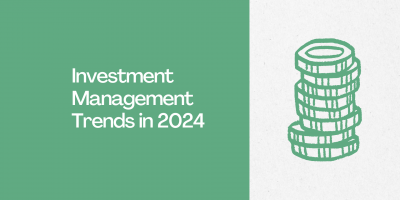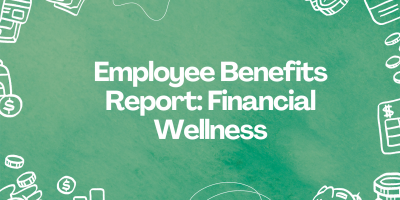
Investment Management Trends in 2025
From emerging technologies and the wealth transition to a shift in growth and tax strategies, here are the most significant investment management trends shaping 2024.

Understanding the cost for a 401(k) provider can be confusing, with a wide variety of plans available and flexibility and complexity in fee structures. It’s essential to be diligent and thorough when evaluating 401(k) provider options.
A retirement program, typically a 401(k) plan, is a cornerstone of a comprehensive employee benefits plan offering and will help companies attract and retain exceptional employees.
Additionally, with tax advantages for both the participant and employer, 401(k) plans can be a sound business decision for many companies.
There are usually two categories of services provided with any 401(k) plan, plan administration or investment management.
Plan administration includes services such as:
Investment management services include:
You may also consider 401(k) service providers who provide multiple services for a single fee, often called “bundled services.”
Today, small and large companies that want to offer their employees 401(k) retirement plans have several options to quickly and efficiently get one up and running. With numerous providers, costs have dropped dramatically, along with bundled services like recordkeeping and plan administration.
The purpose of this guide is to provide employers with the basic information needed to coordinate the selection of a provider for your 401(k)-retirement plan.
This guide is designed to help you navigate the buying process for the 401(k) providers and enable your organization to:
Too many employers shop for 401(k) service providers backward – they dive headfirst into shopping before they understand their options. Without identifying, preparing, and knowing your options, it is easy for 401(k) providers to sell unnecessary or overpriced services resulting in personal liability for 401(k) fiduciaries.
The first step is simple but crucial to an effective start to the selection process.
Begin by understanding what “fiduciary” means and what are your legal responsibilities as an employer.
Fiduciaries must act in the sole interest of plan participants.
This involves ensuring that the plan adheres to the law and governing plan documents, has reasonable fees, and offers diversified investments. Once you understand your role and responsibilities to the plan’s participants, you can better manage the complexities and obligations of selecting a 401(k) provider.
Tax laws and regulations provide strict guidelines for all 401(k) plans to follow. Thus, when comparing providers, you should consider the investments, features/services, flexibility in plan design, and overall financial stability and structure.
Your company’s procurement processes, objectives, and time will heavily influence the time it takes to select a provider, but a general guideline is to allow 60-to-90 days.
Is a 401(k) program a new venture for your organization?
If so, allow yourself more time to work through the learning curve, and consider hiring an expert to help you. Are you replacing an existing solution?
Clearly inventory and document your current program’s features and functionality on measurable criteria such as:
Review your organization’s plan documents, read and consult with financial experts to ensure you understand the provisions of your plan, the operational procedures, and how the plan design fits within the organization’s objectives.
Consider what services you lack for your plan – legal, accounting, recordkeeping, trustee, investment management, investment education, or advice.
By understanding all the services that compose a 401(k) plan, you can quickly determine for which of those services you will need professional assistance.
Pinpoint areas that aren’t working or are missing, and identify preferred changes with a new provider partner.
However, don’t forget to document what IS working, lest you lose that with your new provider. Having a defined list of criteria and outlining your “must-haves” and “nice-to-haves” will be invaluable as you undertake the evaluation process.
Low utilization and employee participation signals discontent or indifference to your current 401(k) plan.
Each employee’s financial situation and goals are different, and employers must remember the importance of personal context. Employee satisfaction surveys can reveal why your employees aren’t using this benefit and what is lacking in the current plan.
Once you narrow down what is missing, you can request changes from your current provider – or look for another provider that can better meet the needs of your employees.
In addition to evaluating employee needs, consider the priorities of your human resources, payroll, and legal experts to ensure their needs are met. They may be involved directly in the selection process or just on the sidelines, but ensure you keep their objectives top of mind as you go through the evaluation process.
Another factor to consider is the performance of your investments.
While you shouldn’t switch providers solely due to short-term market volatility and fluctuations, it might be time to explore other options if you aren’t continuously happy with the investment performance or diversity.
Wise investment choices should generate long-term returns against industry benchmarks, so if you notice consistent below-average performance, consider changing 401(k) providers.
Once you’ve decided which professional services you need for your 401(k) plan, you are ready to start shopping for service providers.
While comparing and interviewing service providers, confirm they deliver the services you want and obtain their “all-in” fee for these services. After contacting multiple prospects, compare their prices and services.
During the second phase, aim to determine if the providers offer low costs, help for your employees, and a tech-friendly platform to minimize manual work for you.
401(k) providers come in all shapes and sizes, from well-established financial heavyweights to tech-focused newer entrants and everything in between.
Some focus on smaller companies, and others focus on medium- or large-sized businesses. Your company culture and requirements will likely guide you in a specific direction.
However, if you have the flexibility, we encourage you to evaluate several different types of providers to get a complete understanding of the landscape.
There are many types of firms providing a variety of 401(k) services. When you’re just starting out, there are some ways to start your research:
Be sure to review your list of current providers, especially those with whom you have a successful relationship. Your financial institutions likely offer 401(k) programs, and many payroll providers and insurance brokers do.
The best practice is to review all investment options and consider things like how many options participants are given, if there is too much or too little choice, and if the fees involved are comparable to others.
Present each potential service provider with identical and complete information regarding the service needs of your plan.
Next, you should ask for formal bids from the providers that seem best suited to your needs. Additionally, it is good practice to ask each prospective 401(k) provider to specify which services are covered in their estimated fees and which are not.
Keep in mind that when you decide to start a 401(k) plan at your company, you’ll likely have a one-time initial fee to set it up. This fee covers activities like setting up the new plan and educating your employees about the plans, and you can expect to pay anywhere between $500 to $2,000.
Once you start to narrow down your search, you may want to verify that the company has a good reputation.
This includes:
With so much employee information stored online, you must ensure that your retirement provider has adequate data security, as retirement plan data is of the utmost importance.
Service providers must have adequate documentation of their data security measures, like a plan to store and protect participants’ data and procedures to follow in the event of unauthorized access.
Consider the level of service and support you receive during the evaluation phase, as often it is an indication of what you and your employees will receive from the 401(k) provider.
Consider things like:
In the end, be mindful of the whole picture – find a provider that can offer support for basic customer service issues and proactive compliance communications.
If your retirement service provider must be licensed (accountants, attorneys, investment managers, or advisors), check with federal and state licensing authorities to confirm the vendor has an up-to-date license and whether there are any pending complaints against the provider.
Even if you hire a retirement plan professional or a financial institution to manage the plan, you, as an employer, retain some fiduciary responsibility for the decision to select and keep an entity as the plan’s service provider.
Therefore, you should document the evaluation activities and prepare a written record of the process you followed in reviewing potential providers. Include the reasons for your selection of a particular provider.
Note: Plan fiduciaries are not required to pick the least costly provider, as the cost is only one factor in the selection process.
|
Desired Services |
Description |
|
Administrative services |
|
|
Participant-focused services
|
|
|
Regulatory and compliance services |
|
Sources: Investment Company Institute, US Department of Labor, and Internal Revenue Service
You’ve gone through a thorough discovery and shopping process, and you’re ready to move forward with a decision!
Congratulations!
Key milestones here include:
Notify the winning provider to whom you’ve decided to ward your business. Take time to map out the following steps and prepare to finalize the contract.
Before you sign any contracts with the service providers, ensure you understand the terms of the agreement and all fees and expenses associated with the contracts. Specifically, understand what obligations you have, and the provider has under the agreement and whether the fees and expenses charged to you and your employees are reasonable and in line with the initial discussions.
The DOL and IRS require that a plan must be in writing.
Your practices and procedures must conform to your plan documents, so you should understand the document’s provisions thoroughly. According to the IRS, the written document serves as the foundation of your day-to-day plan operations. Most commonly, your 401(k)-plan administrator handles this paperwork and will cover topics like:
As an employer, you should also receive a commitment from your 401(k)-service provider to get regular information regarding the services it provides.
You have finally reached the final hurdle to implementing and setting up your 401(k) plan. While it may seem like the hard work is finished, the truth is that this phase is critical to a successful project.
These steps will help things stay on track:
As an employer, you are required to notify all eligible employees and beneficiaries about the 401(k) plan and any changes or updates.
A summary plan description (SPD) is typically created with the plan document that is sent to all plan participants, informing them of the plan and how it operates.
Furthermore, to increase the effectiveness of your company’s 401(k), you can provide employees with information to emphasize your plan’s importance, advantages, and tax benefits.
If you are switching providers, keep in mind that you can’t terminate your current plan and start a new one. Instead, your new provider will administer your current plan – this process is commonly called a “plan conversion.”
Finalizing the plan conversion usually takes about 60-90 days to complete, starting right after you sign a new services agreement.
Effective communication and education are essential at this stage.
Help employees understand how to work with your record keeper and manage their accounts wisely. Many providers offer educational materials that teach employees how to utilize their retirement plans better.
In addition, if your provider offers any digital tools, like calculators, or mobile apps, make sure to promote their use.
While you might think your job is finished once you implement the new plan, keeping an eye on any signs of trouble is important.
Regularly monitor the performance of your 401(k) service providers and ensure they are providing the services in a manner consistent with the agreements.
You should also review participant activity for any comments or complaints about the services or be on the lookout for behaviors that may jeopardize their retirement security, such as taking out more loans or withdrawing money from their plans.
Offering a 401(k) sends a clear message to your workers that you care – and are willing to invest in – their future. Although getting started with evaluating 401(k) provider options isn’t easy, this guide can help equip your organization with the knowledge for a successful selection and implementation process.
Browse our curated list of vendors to find the best solution for your needs.
Subscribe to our newsletter for the latest trends, expert tips, and workplace insights!

From emerging technologies and the wealth transition to a shift in growth and tax strategies, here are the most significant investment management trends shaping 2024.

Understanding the pros and cons of using 401(k) as a first-time home buyer is crucial. Should using the 401(k) as a first-time home
buyer be considered as a last resort?

In an era where 60% of Americans live paycheck to paycheck, companies are increasingly recognizing the urgent need for comprehensive financial wellness programs.

Optimize your 401(k) strategies with key insights for companies and employees, ensuring a secure financial future for all stakeholders.
Used by most of the top employee benefits consultants in the US, Shortlister is where you can find, research and select HR and benefits vendors for your clients.
Shortlister helps you reach your ideal prospects. Claim your free account to control your message and receive employer, consultant and health plan leads.